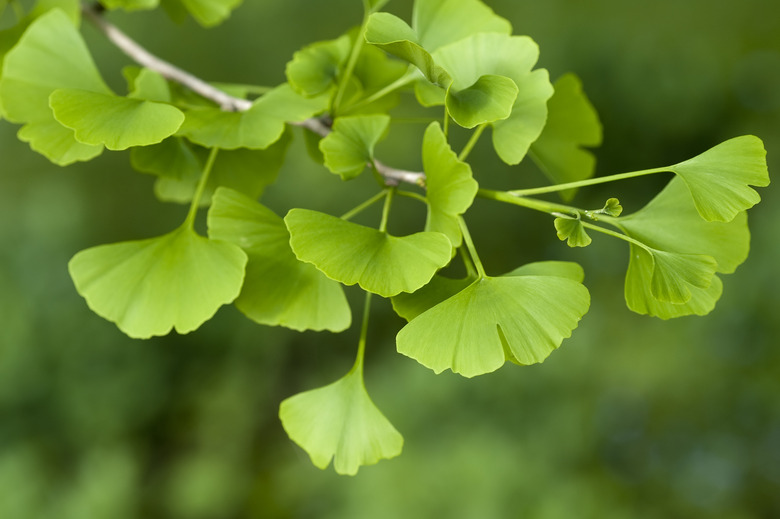How To Care For A Ginkgo Biloba Tree
When established, Ginkgo biloba grows into a large, decorative tree with few care needs. Hardy in U.S. Department of Agriculture plant hardiness zones 3 through 8, Ginkgo biloba is also called maidenhair tree, and features rich green, fan-shaped leaves that turn bright yellow in fall.
When established, Ginkgo biloba grows into a large, decorative tree with few care needs. Hardy in U.S. Department of Agriculture plant hardiness zones 3 through 8, Ginkgo biloba is also called maidenhair tree, and features rich green, fan-shaped leaves that turn bright yellow in fall. The growth rate of a newly transplanted maidenhair tree is slow, though adequate water and fertilizer help the tree establish and grow more quickly. Frost protection isn't needed. The outer pulp of the Maidenhair tree's fruit seeds as well as the raw seed kernels are toxic if ingested, and may also cause dermatitis.
Applying Fertilizer
A slow-release, balanced fertilizer is best for helping a maidenhair tree establish and grow strongly. Keeping the ground free of turf and weeds for 3 to 4 feet around the trunk also benefits the tree.
- When established, Ginkgo biloba grows into a large, decorative tree with few care needs.
- The outer pulp of the Maidenhair tree's fruit seeds as well as the raw seed kernels are toxic if ingested, and may also cause dermatitis**.
- A slow-release, balanced fertilizer is best for helping a maidenhair tree establish and grow strongly.
- **
Apply a granular, 12-4-8 fertilizer product when new growth appears in spring. Sprinkle the granules at a rate of 4 tablespoons per 4 square feet within the tree's drip line, but don't allow the granules to touch the tree's trunk. The drip line is the area where rain drips from a tree's canopy. While the tree is in leaf, apply the fertilizer every three months. Manufacturer's instructions vary between products; always read and follow the instructions on the label.
Watering Maidenhair Tree
Moist soil is best for maidenhair tree, but the tree tolerates drought better than wet soil. The best soil type is sandy and well-drained.
- Apply a granular, 12-4-8 fertilizer product when new growth appears in spring.
- Moist soil is best for maidenhair tree, but the tree tolerates drought better than wet soil.
Water maidenhair tree when the soil surface is dry. Apply water within the drip line of the tree, spraying it evenly over the ground with a garden hose until the water begins to puddle, then stop. Don't water maidenhair tree so much that the soil becomes soggy. A 2-inch layer of organic mulch helps conserve moisture in soil. Spread leaf mold, shredded bark or another light, loose mulch over the root area, and top up the mulch when it thins out, but keep mulch from touching the trunk.
Preventing Problems
It isn't possible to prevent heavy leaf litter from a maidenhair tree, but you can prevent problems with fruit by growing a male cultivar. Maidenhair tree's attractive, bright yellow fall color lasts only a short time before the leaves rapidly drop. Rake up fallen leaves when the tree is bare, and pile them in a corner of the yard to use as leaf mold the following year.
- Water maidenhair tree when the soil surface is dry.
- Maidenhair tree's attractive, bright yellow fall color lasts only a short time before the leaves rapidly drop**.
- Rake up fallen leaves when the tree is bare, and pile them in a corner of the yard to use as leaf mold the following year.
A female maidenhair tree produces plum-shaped fruit that's not only toxic, but smelly and messy when it falls. Most nurseries and garden centers stock only male maidenhair tree cultivars. Check with the staff if you're unsure whether the tree you want to buy is male, and don't grow a maidenhair tree from seed because you won't know if it's male or female. It takes 20 years or longer for a female maidenhair tree to produce fruit.
Pruning an Established Tree
Pruning is rarely required for an established maidenhair tree, but you should remove dead, damaged or crossing stems. Maidenhair tree naturally grows into an open, round or pyramid-shaped form.
Sterilize pruning shears by wiping the blades with a cloth that was dipped in rubbing alcohol, and prune maidenhair tree before new growth appears in late winter or early spring. Prune dead, damaged or crossing stems where they join the rest of the tree.
- A female maidenhair tree produces plum-shaped fruit that's not only toxic, but smelly and messy when it falls.
- Most nurseries and garden centers stock only male maidenhair tree cultivars.
- Sterilize pruning shears by wiping the blades with a cloth that was dipped in rubbing alcohol,_ and prune maidenhair tree before new growth appears in late winter or early spring.
Selecting a Male Tree
Male cultivars of maidenhair tree are available to suit most garden spaces. Maidenhair tree "Fastigiata" (Ginkgo biloba "Fastigiata") is a tall, upright form for narrow spots where few other large trees fit. Growing 30 to 50 feet tall and 10 to 15 feet wide, "Fastigiata" is hardy in USDA zones 3 through 8.
Maidenhair tree "Troll" (Ginkgo biloba "Troll") is a compact tree for a small garden. This dwarf male cultivar grows into a bushy mound 2 to 3 feet tall and wide, and features rich green to blue green leaves during the growing season. "Troll" is hardy in USDA zones 3 through 9.
